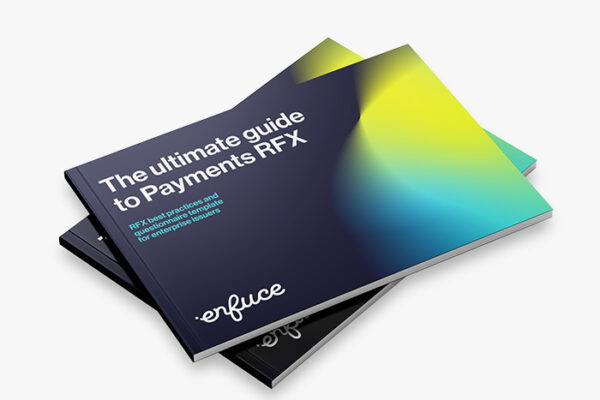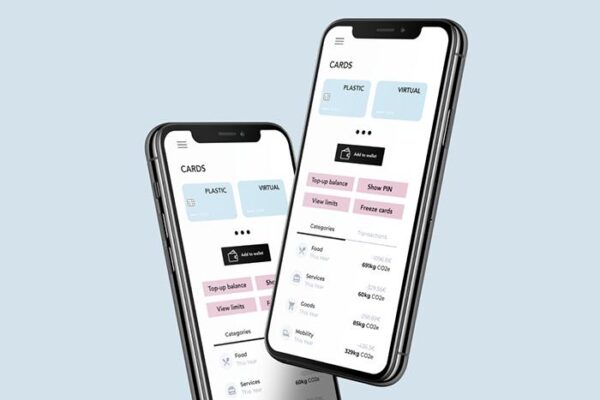How to craft the questions to find your perfect payment partner

It’s wonderful, isn’t it? Having the perfect partner that understands your needs. Someone who stands by your side – making your vision come true together with you.
To find the right card issuing partner, you need to ask them the right questions in your RFX and make sure you and your partner are the right fit. And that you’re worth each other’s money, time and effort.
Good news: Creating your RFX questionnaire doesn’t need to be complicated. All you need to do is focus on two steps:
- Turning your strategic goals into RFX questions
- Adding relevant questions on solution functionality
No need to worry: This blog will walk you through the steps. Then you’ll know to ask the right questions and find the perfect match from a pool of potential partners.
Ready to make your payment card strategy a reality? Let’s get started!
Step 1: Turn your strategic goals into RFX questions
To develop a state-of-the-art payments RFX, it is essential for you to align your strategic goals with specific questions and requirements. This will help you:
- Translate your strategic goals into targeted RFX questions.
- Evaluate potential vendors effectively based on how well they align with your objectives and specific use cases.
- Identify the perfect solution for you and achieve your vision.
Example 1: Drive focused revenue growth with your payment product
Consider these use cases:
- Launching a special payment product for a selected customer segment.
- Aiming to expand into a new geographical market with limited risk and upfront investment.
- Addressing new segment opportunities with tailored offerings
Key questions for potential vendors:
- Can the vendor support corporate cards with specific hierarchies?
- Do they have multi-country capabilities, particularly in European markets?
- Are they allowed to process payments in your region?
- Can they provide proof points on existing customer volume growth?
Example 2: Be relevant and deliver delightful interactions for your customers beyond everyday banking
Consider these use cases:
- Improving your competitive position.
- Preventing users leaving you for your fintech competitors.
Key questions for potential vendors:
- Can the vendor provide references of innovative fintech clients and state-of-the-art use cases?
- Can they offer insights on building customer engagement through payment products?
- Do they have examples of successful new product launches with customers?
- Can they share data on their Net Promoter Score (NPS) across clients?
Example 3: Drive efficiency and self-fund investments
Consider these use cases:
- Significantly reducing operative costs while maintaining customer-facing services.
- Addressing compliance challenges you currently have with your legacy systems.
Key questions for potential vendors:
- How will the vendor reduce your operative load with their service?
- What is the balance between manual work and self-service possibilities for customers?
- Can they clearly define operational tasks handled by you as the customer versus the vendor as the SaaS provider?
- Can they provide an example invoice based on your estimated volume?
Example 4: Ensure stability and reliability in supporting critical processes
Consider these use cases:
- Modernising solutions without impacting corporate customers.
Key questions for potential vendors:
- How does the vendor ensure high availability and service quality?
- Can they provide incident statistics, such as mean time to recovery and time between incidents?
- Can they share an anonymised explanation of their last priority 1 incident, including the resolution time?
- Can they provide references for past migration projects?
Example 5: Maximise potential of your people, tech and data
Consider these use cases:
- Overcoming fragmented service and system architecture.
- Harmonising credit and debit products to eliminate the need for multiple card systems
Key questions for potential vendors:
- How does the vendor’s solution align with your service architecture?
- Can they present a concrete IT architecture renewal approach and support your business renewal?
- Can they assist with transformation and change management?
Step 2: Complement your RFX with the relevant questions on solution functionality
To ensure your RFX covers the necessary solution functionalities, include questions related to service features and technical requirements. This helps you gather the information you need to evaluate the solution’s fit for your needs. And you won’t overwhelm the vendor with unnecessary technical details.
When it comes to technical questions, concentrate on how the solution will achieve your desired outcomes rather than the intricate details of the vendor’s technology. Focus on questions that relate to the impact on your operations and integration possibilities.
Check out the below examples of things to ask, focusing on your specific needs and desired use cases.
1. Service features
Request an explanation of the vendor’s role and functionality, including features like:
- Card issuing
- Payment processing
- Card management
- Fraud prevention
- Compliance with regulations like PSD2
- End-user features: Inquire about the payment features available to end-users.
For the remaining functional questions, be specific and limit their number to cover only the functionalities you expect to need. Some areas to consider include:
- Core functionalities
- Solution creation
- Lifecycle management
- Configurability
- Virtual cards
- Fees and invoices
- Value-added services
- Reporting and analytics
- Available data and insights
2. Development process
When evaluating a vendor, it’s important to understand their development process and testing procedures. This helps you gather information you need to assess the vendor’s commitment to rigorous testing, industry knowledge, and software quality.
Asking relevant questions will provide insights into their update frequency and development standards. Consider including the following example questions for potential vendors:
- How often do you release updates, and what factors influence this decision?
- Are production deployments typically performed without downtime? If not, explain the deployment process and timing.
- Describe your testing procedures, including test automation and the technologies you use.
- Explain your approach to User Acceptance Testing and the environments you use. How do you handle testing that requires production-like data?
- Do you provide a testing sandbox for customers to use?
3. Cloud maturity and strategy
A cloud-based payment platform is crucial for you to handle increased transaction volumes and expand into new markets. Understanding the vendor’s cloud strategy is vital to ensure they can support your current and future needs.
You can gauge the vendor’s preparedness to handle your volumes, scalability, and growth requirements by asking these questions:
- Explain how your cloud strategy is implemented and its impact on your business development processes. Do you use Infrastructure as a Service (IaaS) or Platform as a Service (PaaS) to host your services?
- Have you undergone any assessment of your cloud infrastructure by your provider or a relevant third party? Please share the key findings.
4. Integration
It is key to assess how well a service aligns with your existing systems and integration needs. Consider the feasibility of integrating with core systems such as banking, CRM, ERP, and ticketing systems, as well as end-user interface systems like mobile and web applications. It is essential to set clear expectations and boundaries on integrations, implementation projects, migration requirements, and ongoing production support.
By asking these questions, you can evaluate the vendor’s ability to integrate with your systems, streamline implementation, and support ongoing operations effectively:
- Explain how customers integrate with your service.
- Does your service provide an API for third-party integrations? If so, describe it, including customer requirements and change management strategy.
- Can customers export business data for insights? Provide details if applicable.
- Can we, as a customer, be an integrated part of the processing flow using mechanisms like webhooks?
- Share your API documentation and, if available, sandbox access.
5. Architecture and infrastructure
By asking these questions, you can gain insights into the vendor’s system architecture, infrastructure approach, ability to handle peak traffic, maintenance processes, and adherence to service level agreements:
- Provide an overview of your system’s architecture.
- Is your service fully hosted? If not, describe your hosting requirements.
- Does your system follow a service-oriented architecture? Explain inter-service communication.
- Is your system multi-tenant? Describe how you ensure complete separation between tenants.
- Do you use the same APIs internally as those exposed to third parties? Describe both internal and external API usage.
- What functionality is exposed through APIs? Is all native client and UI functionality available through APIs?
- Do you rely on third-party technologies to run your system? Describe the relevant components and the rationale behind their selection.
- How do you manage high traffic volumes?
- Explain how your SLA is calculated, including the formula used. Do planned maintenance breaks impact uptime?
- Does your system require maintenance breaks? If so, what is the impact on customers?
6. Security and compliance
Assessing the vendor’s security measures and compliance is crucial for safeguarding your business. By asking these questions, you can assess the vendor’s security measures, compliance with industry standards, data storage practices, and readiness to handle potential disruptions:
- Describe your vendor’s overarching security approach.
- Does your service have capabilities to prevent anti-money laundering and terrorism financing? Explain how.
- Describe the scope of your organisation’s PCI compliance and provide relevant certificates. Also, address access control mechanisms and multi-factor authentication, describe the frequency and latest results of penetration testing, data encryption, and the use of HSMs for key-related procedures.
- Where is your data geographically stored?
- Provide details of your disaster recovery plan, including recovery time from backups and frequency of testing
7. Future-proofness (innovation and staying relevant)
Instead of requesting a detailed development roadmap, focus on evaluating their readiness and approach to testing and implementing new features. Proof of Concepts (PoCs) should be efficient and allow for rapid testing in the vendor’s technical environment.
By asking these questions, you can gauge the vendor’s commitment to innovation, their approach to collaboration, and the availability of data and insights to support your business growth:
- What are the vendor’s main themes for future service development?
- How does the vendor plan to enhance their offerings?
- Describe the vendor’s approach to conducting PoCs and trialling new features with customers.
- What data and insights are available to customers to derive additional business value?
Sending your RFXs is just the first step. It’s the lasting success you’re looking for! Payment system migration. New product launches. All in parallel. Check out our playbook and learn how to renew your payment card business.
Struggling with your RFX? Don’t worry, you’ll never be alone. Our top-of-the-industry experts will guide you through the process.



